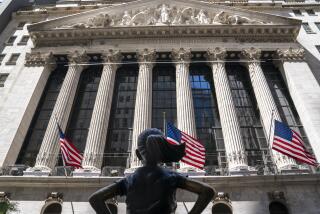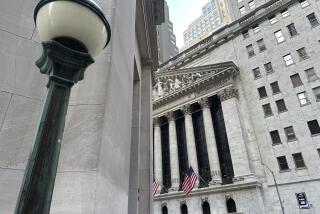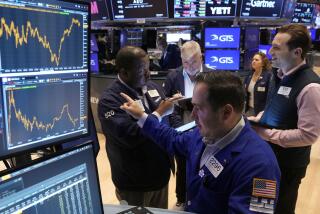Treasury Yields Continue Climb
- Share via
Yields on Treasury securities continued their dramatic rise Friday, capping their worst two-week period in nearly 20 years and pushing up interest rates for home buyers and other consumers.
After rising almost continuously for nearly two years, bond yields have lurched suddenly higher amid the widening belief that the U.S. economy is performing better than many investors had thought possible.
The yield on the benchmark 10-year Treasury bond climbed to 5% on Friday--its first close at that level since mid-August--from 4.95% on Wednesday. The yield on the two-year note surged to 3.16% from 3.07%. (The bond market was closed Thursday for Thanksgiving.)
Many experts predict the rate spike will begin to peter out next week. The selling frenzy that caused the recent rise in yields has become as overblown as the buying mania that preceded it, they say.
Nevertheless, the jarring move in the normally staid bond market illustrates the degree to which perceptions about the economy have shifted in just two weeks.
“We’ve had a complete reversal in market psychology,” said Mark Vitner, an economist at Wachovia Securities in Charlotte, N.C. “A couple of weeks ago, the economic news was all negative, the news from Afghanistan was all negative, and it looked like we were in for a long winter.”
Now, a growing contingent of experts says the economy, no doubt ensnared in a recession, could experience a relatively mild downturn. Data released in the last few days, such as a drop in first-time unemployment benefit claims, indicate such a scenario.
“What’s going on in the bond market is [investors] are anticipating an imminent economic recovery,” said Paul Kasriel, chief economist at Northern Trust Co. in Chicago.
But good news for the economy can be painful for bond investors. The current two-week bond slump is the most severe since 1982, according to Bloomberg News, and has been especially damaging because it follows one of the biggest booms in 40 years.
Many investors loaded up on Treasuries in recent weeks when it appeared that the Federal Reserve would slash interest rates for the 11th time this year--a prospect that is now uncertain.
Two sets of investors were heavy buyers of Treasuries lately, and both have suffered stinging losses, experts said.
First, some big investors who normally buy short-term notes ventured into longer-term, higher-yielding securities as rates fell, said Gary Schlossberg, an economist at Wells Capital Management in San Francisco.
Second, holders of so-called mortgage-backed bonds also piled into Treasuries, experts said. They feared their mortgage holdings would be hurt by a further drop in interest rates as home buyers traded in their home loans for new, lower-rate mortgages.
They loaded up on Treasuries as a hedge, figuring those bonds would fare well in what they expected would be a further slide in rates.
But when rates shot higher, both groups of buyers rushed to unwind their Treasury positions, thus exacerbating the sell-off, experts said.
The calculus for bond investors is very simple:
A new 10-year bond bought on Nov. 7--the trough in the market--would have yielded 4.18%. But with the 10-year now yielding 5%, the value of the older bond has been reduced.
Rising interest rates are being felt in some parts of the economy but are not yet high enough to cause significant damage, experts said.
Rising rates “won’t have an overwhelming [negative] effect unless they continue to rise,” Schlossberg said.
The most noticeable effect has been in the mortgage-refinancing arena, where activity has slowed from its recent feverish pace. Mortgage rates surged this week to their highest levels in two months, thwarting some would-be deals.
The two-month stock market rally is draining some investors from bonds. As stocks have shot up, some investors have cashed in their bonds to buy stocks. But equities could suffer if rates climb further.
Some experts expect bond yields to begin falling again. They say some of the recent data suggesting an improving economy are misleading. For example, after an initial surge because of zero-interest financing, car sales appear to be falling back, they say.
“One reason the economy looks so good today is that it looked so bad in September,” Wachovia’s Vitner said. “If you look at the economy today versus where it was in August, it becomes crystal-clear that the economy is much weaker today and that we’re still losing momentum.”
(BEGIN TEXT OF INFOBOX / INFOGRAPHIC)
SOARING RATES
Treasury yields continued their recent climb Friday as hopes dimmed for further Fed rate cuts.
*--*
Treasury term Yield Nov. 7 Friday 6-month 1.73% 2.03% 2-year 2.29 3.16 5-year 3.47 4.38 10-year 4.18 5.00 30-year 4.79 5.37
*--*
Source: Bloomberg News *
Bloomberg News was used in compiling this report.
More to Read
Inside the business of entertainment
The Wide Shot brings you news, analysis and insights on everything from streaming wars to production — and what it all means for the future.
You may occasionally receive promotional content from the Los Angeles Times.










